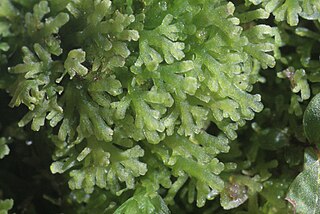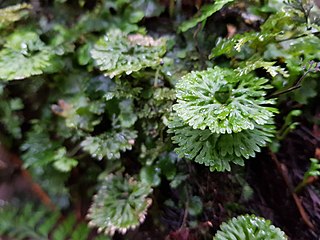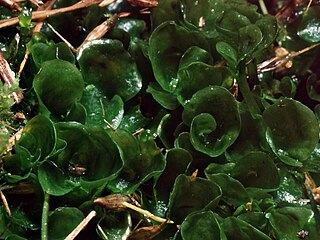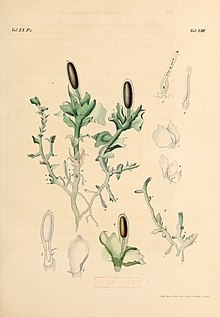
The Marchantiophyta are a division of non-vascular land plants commonly referred to as hepatics or liverworts. Like mosses and hornworts, they have a gametophyte-dominant life cycle, in which cells of the plant carry only a single set of genetic information. The division name was derived from the genus name Marchantia, named by French botanist Jean Marchant after his father.

Marchantiales is an order of thallose liverworts that includes species like Marchantia polymorpha, a widespread plant often found beside rivers, and Lunularia cruciata, a common and often troublesome weed in moist, temperate gardens and greenhouses.

Marchantiopsida is a class of liverworts within the phylum Marchantiophyta. The species in this class are known as complex thalloid liverworts. The species in this class are widely distributed and can be found worldwide. Complex oil bodies are only found in the gametophyte.

Lunularia is a genus of liverworts whose only species is Lunularia cruciata, the crescent-cup liverwort. Lunularia is either the only genus in the order Lunulariales, or may be placed in the order Marchantiales. The name, from Latin luna, moon, refers to the moon-shaped gemma cups.

Jungermanniales is the largest order of liverworts. They are distinctive among the liverworts for having thin leaf-like flaps on either side of the stem. Most other liverworts are thalloid, with no leaves. Due to their dorsiventral organization and scale-like, overlapping leaves, the Jungermanniales are sometimes called "scale-mosses".

Metzgeriales is an order of liverworts. The group is sometimes called the simple thalloid liverworts: "thalloid" because the members lack structures resembling stems or leaves, and "simple" because their tissues are thin and relatively undifferentiated. All species in the order have a small gametophyte stage and a smaller, relatively short-lived, spore-bearing stage. Although these plants are almost entirely restricted to regions with high humidity or readily available moisture, the group as a whole is widely distributed, and occurs on every continent except Antarctica.

Sphaerocarpales is an order of plants within the liverworts. Approximately twenty species are in this order which is sub-divided into four families: Monocarpaceae, Sphaerocarpaceae and Riellaceae, as well as the extinct family Naiaditaceae. The inclusion of the Naiaditaceae is uncertain, and the family has sometimes been assigned to the Calobryales.

Jungermanniopsida is the largest of three classes within the division Marchantiophyta (liverworts).

Aneuraceae is a family of thallose liverworts in the order Metzgeriales. Most species are very small with narrow, branching thalli.

Herbertaceae is a family of liverworts. The family consists of the genera Herbertus, Schisma and Triandrophyllum. The genus HerpocladiumMitten, 1873 was later merged into the genus Herbertus.

Hymenophyton flabellatum is a species of the order Pallaviciniales (liverworts), one of perhaps several species in the genus Hymenophyton. It is a dendroid thalloid liverwort belongs to the family Hymenophytaceae and is commonly known as Fan liverwort. It is found in New Zealand, Chile, and common in wet forests of Australia and Tasmania. Hymenophyton flabellatum closely resembles with small filmy fern, Hymenophyllum and can be confused with the liverwort, Symphyogyna hymenophyllum.

Aytoniaceae is a family of liverworts in the order Marchantiales.

Pleurozia is the only genus of liverworts in the family Pleuroziaceae, which is now classified in its own order Pleuroziales, but was previously included in a broader circumscription of the Jungermanniales. The genus includes twelve species, and as a whole is both physically distinctive and widely distributed.
Pseudolepicoleaceae is a family of liverworts in the order Jungermanniales.

Cephaloziaceae is a family of liverworts.
Haplomitrium hookeri, or Hooker's flapwort, is a species of liverwort. It occurs in Europe, Asia, North America and New Zealand.
Haplomitrium minutum is a liverwort from New Zealand.

Neohodgsonia is a genus of liverworts containing the single species Neohodgsonia mirabilis. Neohodgsonia is the only genus in the family Neohodgsoniaceae, which is the only family in the order Neohodgsoniales.

Pelliales is an order of liverworts.

Pallaviciniales is an order of liverworts.
















